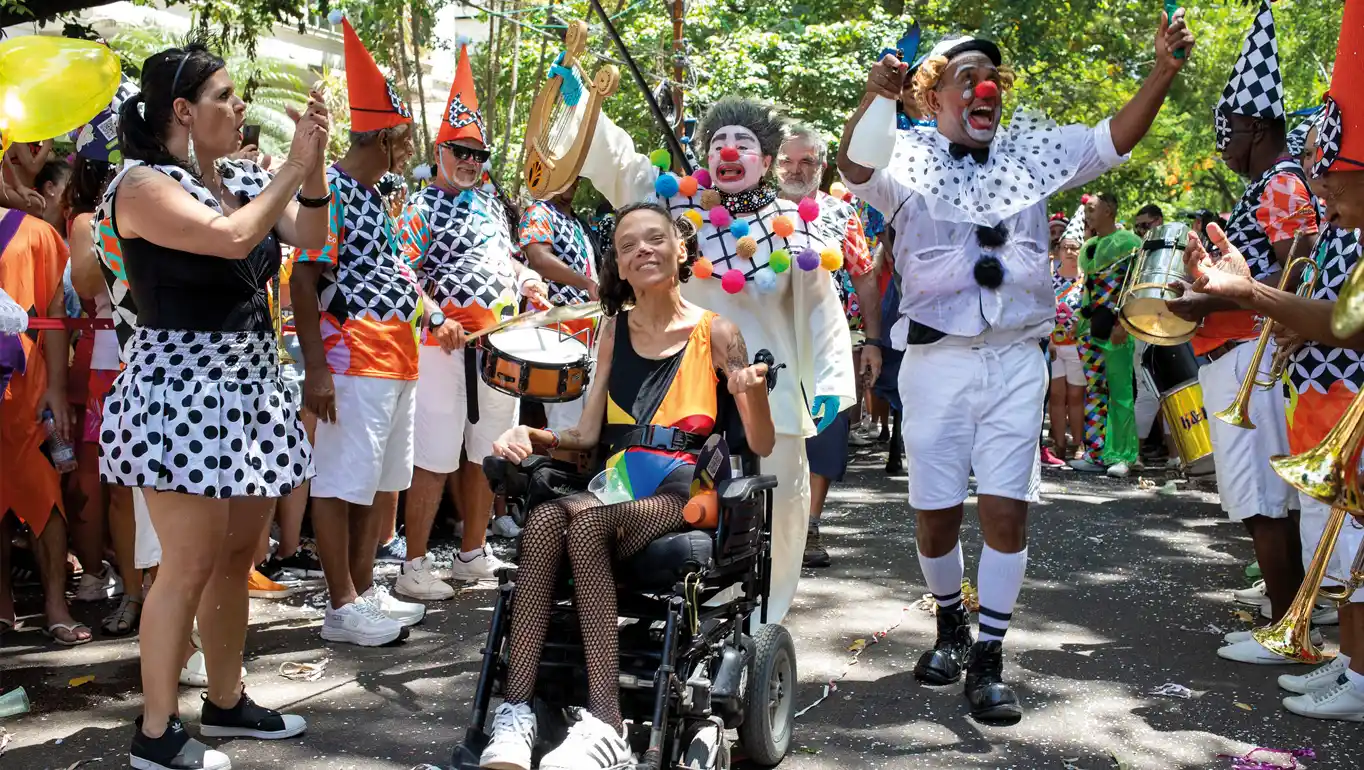Rio de Janeiro’s Carnival is famous for its dazzling parades, electrifying street parties, and unbridled joy. But beyond the glitter and samba beats, a quieter revolution is happening—one that is making Carnival more inclusive for people with disabilities.
For over two decades, the bloco named Loucura Suburbana has been a driving force in bringing the disability inclusion agenda to Carnival. A bloco—one of the hundreds of street bands that define Rio’s grassroots Carnival—Loucura Suburbana emerged from a mental health initiative at the former Pedro II Psychiatric Centre, now the Nise da Silveira Municipal Institute of Health Assistance.
Founded in the early 2000s, Loucura Suburbana has become one of the strongest symbols of the anti-asylum movement in Brazil. It was conceived as a way to reintegrate psychiatric patients into public life and challenge the institutionalized isolation they had long endured. “In 2000, we created an arts workshop, and from there came the idea of a Carnival ball,” recalls Ariadne de Moura Mendes, a psychologist and former Ministry of Health employee who was involved in the initiative’s early days. “At the time, everything took place within psychiatric hospitals, where thousands of patients lived cut off from society.”
Determined to change this, the bloco began taking patients to the streets, turning Carnival into a platform for social reintegration. What started as an internal event soon gained momentum, transforming a former garage into a bustling workshop for costume-making and samba rehearsals. Musicians from Rio’s renowned samba schools, such as Unidos da Tijuca and Caprichosos de Pilares, lent their talents to help bring the parade to life. “The parade not only changed the lives of the patients but also transformed the institution’s dynamics,” says Ariadne.
However, the debut was not without its challenges. “The local residents were afraid of the patients,” Mendes explains. “At first, the neighborhood of Engenho de Dentro was uneasy about seeing people who had previously been institutionalized now dancing in the streets.” But as the years went by, the parade became a beloved fixture of the community, a symbol of resilience and a challenge to the stigma surrounding mental illness.
The success of Loucura Suburbana inspired similar initiatives, such as Tá Pirando and Loucos pela Vida, further integrating mental health advocacy into Rio’s Carnival traditions.
Samba schools embracing accessibility
Beyond the street parades, Rio’s famed Sambadrome—a vast arena designed by architect Oscar Niemeyer—has also been making strides toward inclusivity. While it is not uncommon to see dancers and musicians in wheelchairs performing in major samba schools, Embaixadores da Alegria is the first samba school explicitly dedicated to people with disabilities.
Founded in 2006, Embaixadores da Alegria aims to use samba, art, and education as tools for social inclusion. The school has now participated in 16 consecutive parades at the Sambadrome, engaging with over 80 institutions and reaching more than 19,500 people through accessible events, workshops, and performances.
On 8 March, they took to Avenida Marquês de Sapucaí to open the Champions Parade, bringing together around a thousand revelers to celebrate both Carnival and the rights of people with disabilities. “Culture and samba are bridges to inclusion, bringing people together and breaking down barriers,” the association emphasizes.
Despite these strides, accessibility remains a challenge at the Sambadrome. While some areas feature accommodations such as ramps and designated seating, other sections lack elevators, making it difficult for those with mobility issues to move freely. Equally, the intense lighting effects of the parade can also be problematic for people with sensory sensitivities or visual impairments.
In an effort to address these concerns, Rio’s Municipal Secretariat for People with Disabilities (SMPD) provided 3,600 free tickets to people with disabilities and their companions for the days of parades. They also introduced noise-canceling headphones for attendees with sensory processing challenges, as well as audio descriptions for visually impaired spectators and Brazilian Sign Language (Libras) interpreters.
Honoring a legacy of resilience
This year’s Carnival also paid tribute to a remarkable figure in Brazilian music. The traditional samba school Império Serrano honoured Beto Sem Braço (born Laudeni Casemiro in 1940), a prolific composer who turned the loss of his right arm as a child into his stage name—sem braço in Portuguese means ‘without an arm.’ He went on to become one of the most celebrated figures in Brazilian Carnival history.
His song ‘Bum Bum Paticumbum Prugurundum’ propelled Império Serrano to victory in 1982 and remains one of Carnival’s most iconic anthems. As the lyrics declare: “Come, my love, send the sadness away / It’s Carnival, it’s revelry, no one cries today.”
As Brazilians say, the year only truly begins after Carnival. And in this new year, advocates for disability inclusion will continue working to ensure that Carnival is more than just a party—it is a stage for transformation, making its joy truly universal.



